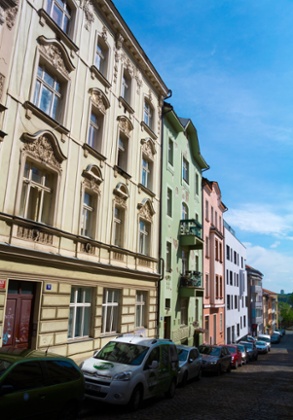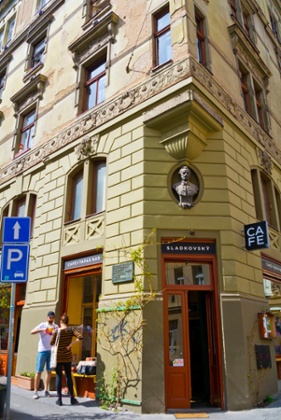David Farley, The Guardian, October 26, 2015
The barista with the Salvador Dalí moustache refused to bring milk for my coffee. “Trust me,” he said, adjusting his man-bun. “It’s much better this way.” The snobbery didn’t surprise me. What did was that it happened in Prague, a place where, until the end of the last decade, coffee was little more than sludge. Even more shocking was that this was the Karlín district, a once-crime-ridden part of town closest to the Križíkova metro station that, until recently, offered little reason to visit. I was at Muj šálek kávy, one of a handful of speciality coffee spots sprinkled throughout the city. But a lot more than coffee culture has changed in the Czech capital.
When I lived in the Czech capital for three years in the mid-1990s, I spent my nights in the central Old Town and Malá Strana districts, where all the best places to eat, drink and shop existed. Now the centre of Prague, while still one of the most beautiful cities in the world, has given way to the march of mass tourism, and its denizens have retreated to the outer neighbourhoods. And although it’s hard for anywhere else in the city to compete with the aesthetics of Charles Bridge, Prague Castle and Old Town Square, I yearned for the other Prague, the one where locals – hipsters, scenesters and even coffee snobs – hung out.

‘Crammed with Art Nouveau and neo-classical buildings, some in need of love more than others’: the colourful Vršovice neighbourhood. Photograph: Alamy
I began my search in Vršovice (pronounced Vir-sho-veetz-say), a neighbourhood that is a 15-minute tram ride from the centre of town. I lived here for about two years and, at the time, found little to entice me, save the bed I passed out in after a long day at work. At first sight, it looks no different from before. Set on a downward slope, Vršovice is crammed with Art Nouveau and neo-classical buildings, some in need of love more than others. The cobblestones are uneven. Many of the streets have an intriguing curve to them. And then you see a shaggy-haired 25-year-old guy in skinny jeans come around the corner and enter what appears to be a vegan restaurant called Plevel. Later, you walk into a café and hear indie bands seeping from the speakers.
My home on this visit was the Czech Inn, a quasi-industrial hotel that towers at the top of Krymská Street, maybe the hippest lane in the city. I met up with Ondrej Kobza, the owner of Café V Lese, the place that got Vršovice’s metamorphosis going. “After I opened Café V Lese five years ago,” said Kobza, who appears to be the unofficial mayor of the town, “I recruited my friends to open up places in the neighbourhood. Soon enough Plevel opened, then Družina, a creative arts studio moved in. That attracted a lot of artists. And it just kept going.”
Kobza always had his sights on more than just cafés. A couple of years ago they shut down the street to traffic and had a day-long party. He put a piano out for anyone to play. Now Kobza has placed pianos all around the city. His next project is public chess tables. “We have to reimagine the city to our liking and that’s what I’m trying to do.”

‘Wes Anderson chic’: Sladkovsky bar and cafe, which does a mean goulash. Photograph: Alamy
Later that night I popped into Café Sladkovsky – a pub/café bedecked in old photographs and kitsch wallpaper that could be described as Wes Anderson chic – and ordered goulash. This was a slightly different take on the traditional Czech dish, with boar instead of beef, and a potato pancake in place of the usual dumplings. It was a delicious twist on the original.
The next day, I walked across the Vinohrady and Žižkov neighbourhoods, a pleasant 25-minute stroll, to get to Karlín. Many of my Czech friends in their 30s and 40s had told me they had been hanging out here a lot lately. And so I came to Muj šálek kávy, the coffee spot that frowns upon the marriage of milk and coffee, to meet up with Jan Valenta and Zuzi Danková. They run Taste of Prague, a popular food-themed walking tour.
“The first time I noticed something going on in this neighbourhood was five years ago when this café opened up,” said Jan. But Zuzi pointed out that the area’s regeneration really goes back to the 2002 when the nearby Vltava river flooded, taking out centuries-old buildings and leaving the place practically abandoned. “That made property values very affordable and quickly there were a lot of new investments along the river.”
The office buildings make Karlín feel like an adult version of Vršovice: during the day, upwardly mobile office workers flood the area’s cafés and restaurants. At Garage, a diminutive eatery, I dined on the Canadian snack poutine (French fries smothered in gravy). The owner told me this used to be a rough neighbourhood, “but the floods washed away everything, even the bad parts.”
The liveliest place in the neighbourhood, Lokál, a gastropub, was packed every night; Veltlin, a bar that only serves wine made from within the old border of the Austro-Hungarian Empire, was similarly crowded. But you sensed a difference in the clientele: while the younger locals might gravitate to Vršovice, if you’re over 30, Karlín could be more your style. It certainly was for me – at least, once I’d learned to stop taking milk in my coffee.
Essentials
Flights from London Heathrow to Prague with British Airways (britishairways.com) start from £50 each way. At Czech Inn, dormitory beds start from £4, rooms with a shared bathroom start at £32, and rooms with a private bathroom start at £35 (czech-inn.com)
This article originally appeared on guardian.co.uk
This article was written by David Farley from The Guardian and was legally licensed through the NewsCred publisher network.
![]()